Tulbaghia maritima
Tulbaghia maritima Vosa
Family: Amaryllidaceae
Common names: Garden Route garlic, coast wild garlic (Eng), kuswildenoflok (Afr.)
Introduction
Tulbaghia maritima is a small wild garlic that grows along the seashore in the Garden Route, with pink flowers in summer; it is sure to become a popular garden ornamental and is ideal for coastal gardens.
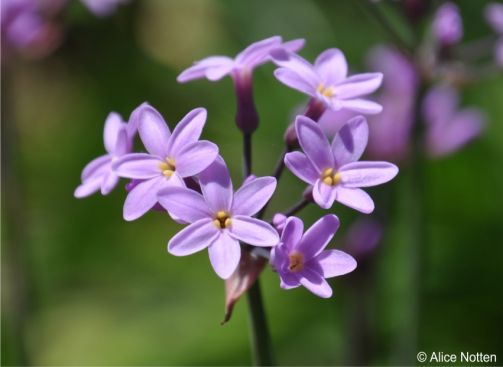
Description
Description
Tulbaghia maritima is a herbaceous perennial with a short and poorly formed rhizome and many fleshy roots. The leaves are 100-150 mm long and 9-12 mm wide, shiny dark green, numbering 10-15 per plant, linear, longitudinally ribbed with visible vascular bundles and rounded tips, and tending to be recumbent rather than erect. The flower stalk is erect and longer than the leaves, topped with an umbel of 6-12 flowers. The flowers are shell pink to light purple, occasionally white, with a funnel-shaped base, 7-8 mm long. Within the flowers 3 small, blunt or bifid, yellowish to deep orange coronal lobes can be seen, these lobes tend to bend inwards as the flowering period comes to an end. The ovary is small, elliptical to mitre-shaped. The short style (<1 mm) is accompanied by a rounded, yellowish stigma with tiny translucent, domed papillae. The seed capsule is rounded, mitre-shaped with rounded tips. The seed capsule splits longitudinally when ripe to reveal black, elongated triangular seeds, 1.5-2.5 mm long.
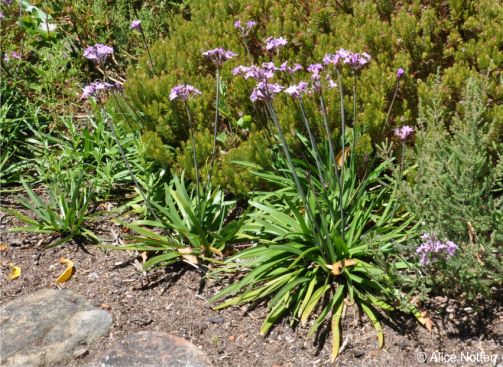
Tulbaghia maritima is similar to the the species Tulbaghia violacea, however its leaves are shorter and wider, and its flowers are somewhat smaller than those of T. violacea, and have yellowish-green corona lobes.
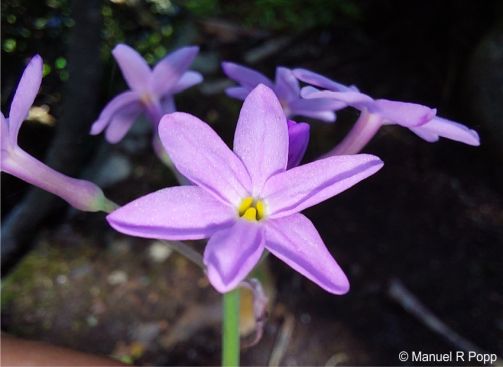
Conservation Status
Status
Tulbaghia maritima is assessed as Vulnerable (VU) on the Red List of South African Plants. This can be attributed to its small natural range and the ongoing degradation and loss of its habitat to make room for coastal and tourism infrastructure development. This conservation status highlights the ecological sensitivity of the species and the importance of protecting its remaining coastal habitats.
Distribution and habitat
Distribution description
Tulbaghia maritima is a coastal plant species endemic to the Eastern Cape Province of South Africa. It is distributed from Nature’s Valley to the mouth of the Gamtoos River, the area of distribution falls within the Humansdorp and Willowmore districts. This species grows close to the seashore, often in coastal forest or at river mouths, where it thrives in sandy soils amongst rocks. Tulbaghia maritima favours steep gorge-like terrain, with dense vegetation, the conditions of which alternate between freshwater input from rivers and saline water from the sea. This marine-influenced habitat’s environmental conditions are unique and challenging for seed germination and plant growth.
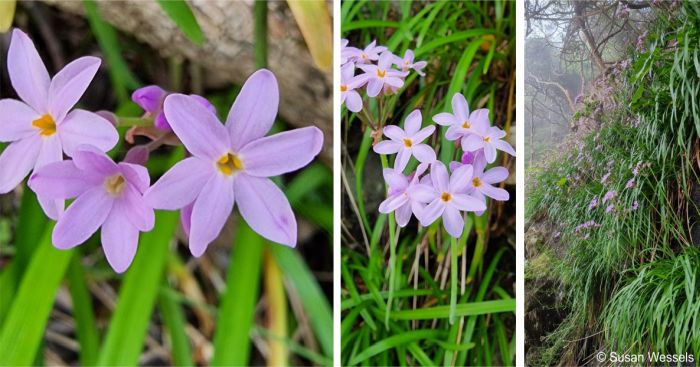
Derivation of name and historical aspects
History
The genus Tulbaghia was established by Linnaeus in 1769, based on plant specimens sent to Europe by C.R. Rijk van Tulbagh, the then Governor of the Cape Province. The specific epithet maritima comes from botanical Latin, meaning ‘of the sea’ or ‘coastal’, in reference to the species’ natural habitat along the coast.
Tulbaghia maritima was formally described in 2011 by C.G. Vosa. It was previously considered to be a variety of Tulbaghia violacea but was elevated to species status following extensive fieldwork and taxonomic research. This work revealed clear morphological distinctions between the two taxa, as well as the unique and specific habitat requirements of Tulbaghia maritima. A 2016 phylogenetic study by Stafford et al upholds this status, showing that T. maritima forms a strongly supported clade of its own, beside one containing T. violacea and T. cominsii.
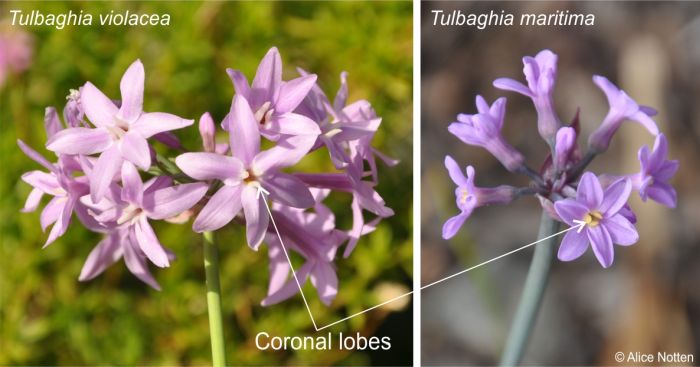
The genus Tulbaghia is made up of approximately 30 species, most of which are bulbous. Tulbaghia belongs to the family Amaryllidaceae. Historically, the genus was classified under the family Alliaceae, however, molecular phylogenetic studies have since led to its reclassification into the Amaryllidaceae family, specifically within the subfamily Allioideae.
Ecology
Ecology
Tulbaghia maritima is a resilient coastal species, that is well adapted to survive in the challenging conditions of its native habitat, which includes nutrient-poor sandy soils, salty coastal winds, and intense sunlight. Its underground bulb plays an important role in storing water and nutrients, allowing the plant to endure periods of drought and seasonal climatic variation.
The species produces attractive, nectar-rich flowers that release a sweet scent, aimed at attracting insect pollinators such as bees and butterflies. Although there are limited studies on this species’ pollination ecology, it however is likely that long tongued bees are one of the primary pollinators of T. maritima, as this is a pattern that has been observed in other Tulbaghia species. These pollinator interactions are crucial for seed production and genetic diversity in fragmented coastal populations.
Seed dispersal in T. maritima is mainly by gravity, with seeds falling close to the parent plant. However, occasional dispersal by wind or water movement is possible in its open, coastal environment.
A distinctive feature of Tulbaghia species is the release of a strong garlic-like scent when the leaves are crushed. This is due to sulfur containing compounds that are the same as those found in garlic and which serve as a chemical defense mechanism, deterring herbivores and certain insect pests. This adaptation is especially beneficial in environments where grazing pressure may be high.
Although Tulbaghia maritima is not fire-adapted in the normal sense, its underground storage organ allows it to be able recover after fires, a useful trait in fire-prone coastal ecosystems. This resilience contributes to its persistence in natural habitats affected by fire and drought cycles.
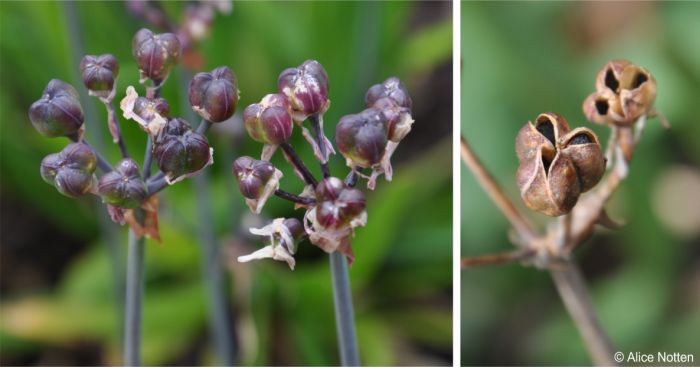
Uses
Use
As a newly described species, Tulbaghia maritima has not been studied extensively enough to reveal any major cultural uses but has potential in the ornamental industry due to its striking inflorescence.
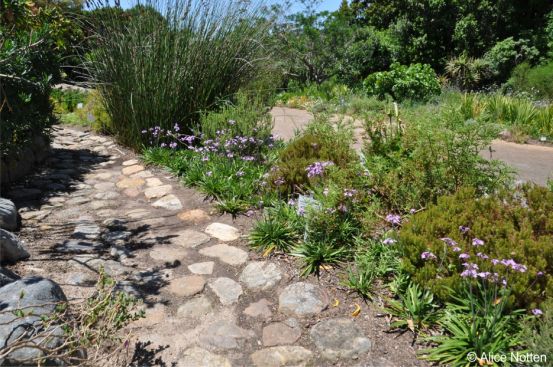
Growing Tulbaghia maritima
Grow
Tulbaghia maritima can be propagated sexually and asexually. Seeds should be collected once the seed capsule splits open, indicating that the seeds have matured. Sow seeds in spring, in deep seed trays, in a well-draining medium with lots of compost.
Tulbaghia maritima forms clumps that can be lifted and divided in to smaller clumps or individual tubers. The divided plants should be planted out in an area of the garden that is in full sun or partial shade. Try not to disturb the transplanted plants for as long as possible to allow time for the plant to acclimatize. Tulbaghia maritima grows well in fertile, well-draining, loamy soils.
Tulbaghia maritima can brighten up city or courtyard gardens, flower borders, wall or side borders and forms a colourful groundcover. Unlike other Tulbaghia species, Tulbaghia maritima does really well in coastal gardens due to its habitual adaptation to coastal environments. It is also suitable for containers.
Tulbaghia are typically free of most pests and diseases, however snails, slugs and lily borer (favours members of the Amaryllidaceae family) cause a lot of damage to the foliage. Inspect foliage regularly to avoid heavy damage.
References
- Aremu A.O. & Van Staden, J. 2013. The genus Tulbaghia (Alliaceae) – a review of its ethnobotany, pharmacology, phytochemistry and conservation needs. Journal of Ethnopharmacology 149(2): 387–400.
- Harris, S. 2004. Tulbaghia violacea Harv. (Amaryllidaceae). PlantZAfrica. Online. https://pza.sanbi.org/tulbaghia-violacea.
- Johnson, S.D. & Steiner, K.E. 2000. Generalization versus specialization in plant pollination systems. Trends in Ecology & Evolution 15(4): 140–143.
- Stafford, G.I., et al. 2016. The first phylogenetic hypothesis for the southern African endemic genus Tulbaghia (Amaryllidaceae, Allioideae) based on plastid and nuclear DNA sequences. Botanical Journal of the Linnean Society 181: 156–170.
- Takaidza, S., Pillay, M. & Mtunzi, M. 2015. Biological activities of species in the genus Tulbaghia: A review. African Journal of Biotechnology 14 (5): 3037-3043.
- Van Wyk, B-E. & Wink, M. 2004. Medicinal plants of the world: an illustrated scientific guide to important medicinal plants and their uses. Briza, Pretoria.
- Von Staden, L. 2022. Tulbaghia maritima (Vosa) Vosa. National Assessment: Red List of South African Plants. https://redlist.sanbi.org/species.php?species=483-44.
- Vosa, C.G. 2000. A revised cytotaxonomy of the genus Tulbaghia, (Alliaceae). Caryologia 53: 2 (83–112). https://examine.com/supplements/tulbaghia-violacea/
- Vosa, C.G. 2011. Tulbaghia maritima: A new species from the southeast Cape Peninsula, South Africa (Alliaceae). Herbertia 65: 60-69.
Credits
Siphesihle Precious Sibiya and Yandisa Ndzeku
Kirstenbosch National Botanical Garden
July 2025
Acknowledgements: the authors thank Alice Notten, Susan Wessels and Manuel R Popp for allowing the use of their images, and Graham Duncan for sharing his knowledge on the cultivation of this species.
Plant Attributes:
Plant Type: Bulb, Ground Cover
SA Distribution: Eastern Cape
Soil type: Sandy, Loam
Flowering season: Spring, Early Summer, Late Summer
PH: Neutral
Flower colour: Pink, Mauve/Lilac
Aspect: Full Sun, Morning Sun (Semi Shade), Afternoon Sun (Semi Shade)
Gardening skill: Easy
Special Features:
Horticultural zones








Rate this article
Article well written and informative
Rate this plant
Is this an interesting plant?
Login to add your Comment
Back to topNot registered yet? Click here to register.